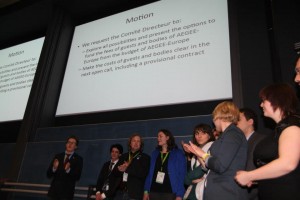Frequent Agora visitors are used to dealing with a lot of proposals during a statutory event. But during recent Agorae a new trend could be spotted: the use of motions. Why are these motions used, and how are they different from proposals? I will discuss these questions basing myself upon my interpretation of the rules on motions in the CIA as well as their use in Parliaments.
Proposals present a written change of the written rules in AEGEE: the CIA. So these proposals create new rules or change the already existing ones in the CIA. We vote on the text in the proposal during the voting sessions at the Agora and when accepted, the Juridical Commission (JC) writes them in the new version of the CIA. Motions will not be put into the CIA, as they are not presented as written rules. So what are they then?
Two types of motions
There are two types of motions described in the CIA (CIA, Working Format of the Agora, Article 6 (1-2); 7(1) and article 10 (7)). The first type is the ‘procedural motion’: during an Agora any delegate can come forward at any time during a plenary if they believe we are not properly following procedures. For example, when the Chair would forget to ask which locals are present at the beginning of a Prytanium, a delegate can raise up two hands (the sign for a procedural motion), and state that the Chair should first check which locals are present.
So the procedural motion is a way for delegates to remind the Chair and other participants that some part of the official procedure is forgotten.
But this is not the motion that we have seen lately. Besides the ‘procedural motion’, there is also the general motion. In our current CIA the motion is only mentioned as a part of a debate. According to the CIA, a representative of the group that brings the motion to the Agora is allowed to make the opening statement in the debate. The time allocated to this discussion, as well as the amount of people that are allowed to respond to the motion presented, are completely up to the Chair although the CIA does state that the time given to those in favour needs to be equal as the time given to those against a motion.
Seeing that there are only rules on how motions should be discussed, this means that when we look at the content of motions, there is no limit at all. Virtually anything can be put forward to the Agora in the form of a motion…
Ways to use motions

The motion for creating a policy for public and internal information was presented at Spring Agora Rhein-Neckar
So far we have seen various motions: there was one on banning smoking at the Agora; another one changing the way the Agora fee is calculated; and another one on creating a policy for public and internal information. These were all very different matters that were put forward. The first three stated that they would like some rules to be developed on a certain matter. What makes these motions different from proposals is that they did not state the actual change, just that they would like a policy to be developed. So these motions are not new rules that were voted upon, but recommendations to the CD and/or other bodies working on different matters.
We have also seen the ‘motions of sadness’ which seem to be a different use of motions. Although these are motions as well, and there is no difference in the way they should be discussed according to the CIA, these were not recommendations given to a European body, but rather like reprimands. Stating that the proposers were disappointed by a certain behaviour and by accepting such motion, the Agora as a whole stated that they were disappointed as well.
This use of motions can also be seen in the Parliaments of certain countries like Canada and the Netherlands. There is no future action that is demanded of anyone by these motions, but they are used as a way to show people that their actions were not appreciated and that they should try to not let it happen again.
Conclusion
So any local can be presenting a motion if they just want to start a debate on anything they want that is not (yet) on the official agenda as proposed by the Chair team. However, you can expect the Chair team to have worked hard on developing the Agenda and so we should be careful with presenting too many motions.
If you want to start a discussion, you can also ask for a progress meeting or maybe a workshop can also help you further develop an idea. If you do believe that the best way to bring an item on the agenda is via a motion, then the best thing is to discuss it with the Chair and agree upon the time that you need to properly present it.
Written by Wieke van der Kroef, AEGEE-Amsterdam/AEGEE-Leuven
Pictures by Dasha Onokhova, AEGEE-Moskva, from the Spring Agora Rhein-Neckar 2013

